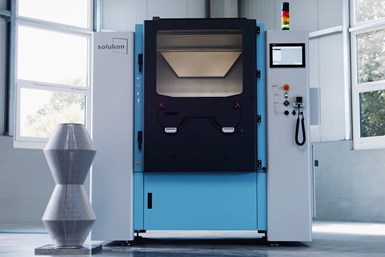Launcher Acquires Solukon Depowdering System for Postprocessing Rocket Parts
The depowdering system removes residual and clogged powder from metal laser-melted parts within a sealed process chamber, using adjustable vibration and automated two-axis part rotation while recovering superfluous powder.

The SFM-AT1000-S powder removal system. Photo Credit: Solukon
American aerospace company Launcher has chosen Solukon’s SFM-AT1000-S powder removal systems for for postprocessing large and heavy rocket parts. Solukon says its depowdering system offers fast and efficient removal of metal powder for applications of up to 1,000 mm high.
The system features Solukon‘s Smart Powder Recuperation (SPR) technology which is said to provide safe, reliable depowdering. The SFM depowdering system removes residual and clogged powder from metal laser-melted parts within a sealed process chamber, using adjustable vibration and automated two-axis part rotation while recovering superfluous powder. Through programmable rotation of the build plate in two axes, unfused metal build material is completely removed from complex channels and geometries, providing an increase in efficiency, safety and quality — all while saving on costs, the company says.
Launcher will also utilize Solukon’s postprocessing knowledge to completely free its rocket engines and combustion chambers from powder. The company currently operates a fleet metal additive platforms and other advanced manufacturing assets from partners, including Velo3D, EOS and AMCM (an EOS company). Launcher says it produces every major part of its transfer vehicle Orbiter and E-2 liquid rocket engine in-house as part of its strategy to build, test and iterate as cost-effectively as possible as it develops high-performance rockets and transfer vehicles.
"We see that automated powder removal is an essential step in the production process. For final heat treatment and hot isostatic pressing, all parts must be free of any powder, a special challenge for large and heavy parts with hard-to-access internal channels,“ says Tim Berry, Launcher’s head of manufacturing. „The SFM-AT1000-S will help to further automize our production process as we achieve reliable and repeatable cleaning results."
The one-meter-high Launcher E-2 engine, first presented in 2019, was made in Germany by AMCM using its specialized M4K printer. With the purchase of the SFM- AT1000-S through Launcher, the wheel has come full circle as this Solukon system was initially developed at the request of AMCM for a depowdering solution for parts exactly from this M4K printer.
The Solukon SFM-AT1000-S, which is an advancement of the SFM-AT800-S-system and a special version particularly designed for large and heavy parts, enables users to easily move parts with a size up to 600 × 600 × 1.000 mm (XYZ) with a weight up to 800 kg. This is said to make it well suited for postprocessing system aerospace and space industry parts.
It is said the SFM-AT1000-S has two endless rotating axes with programmable servo-drives so that it can move the part along any imaginable path. Individual control is also possible by using a joystick to move the component flexibly in any direction at variable speed and to save the movement pattern afterwards. The optional Digital Factory tool enables quality assurance and automation integration of the depowdering process.
Related Content
-
DMG MORI: Build Plate “Pucks” Cut Postprocessing Time by 80%
For spinal implants and other small 3D printed parts made through laser powder bed fusion, separate clampable units resting within the build plate provide for easy transfer to a CNC lathe.
-
Additive Manufacturing Is Subtractive, Too: How CNC Machining Integrates With AM (Includes Video)
For Keselowski Advanced Manufacturing, succeeding with laser powder bed fusion as a production process means developing a machine shop that is responsive to, and moves at the pacing of, metal 3D printing.
-
This Year I Have Seen a Lot of AM for the Military — What Is Going On?
Audience members have similar questions. What is the Department of Defense’s interest in making hardware via 3D printing over conventional methods? Here are three manufacturing concerns that are particular to the military.














